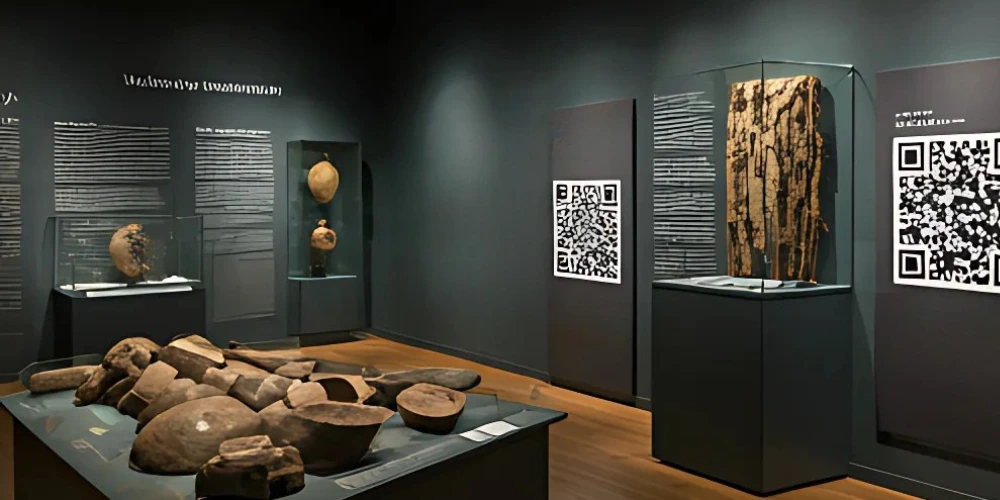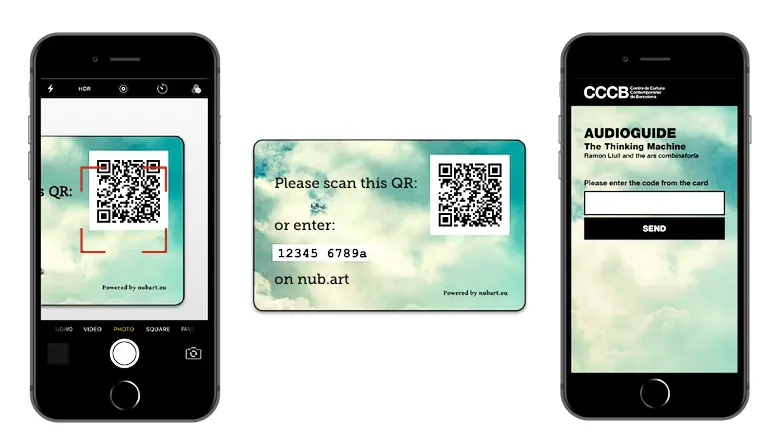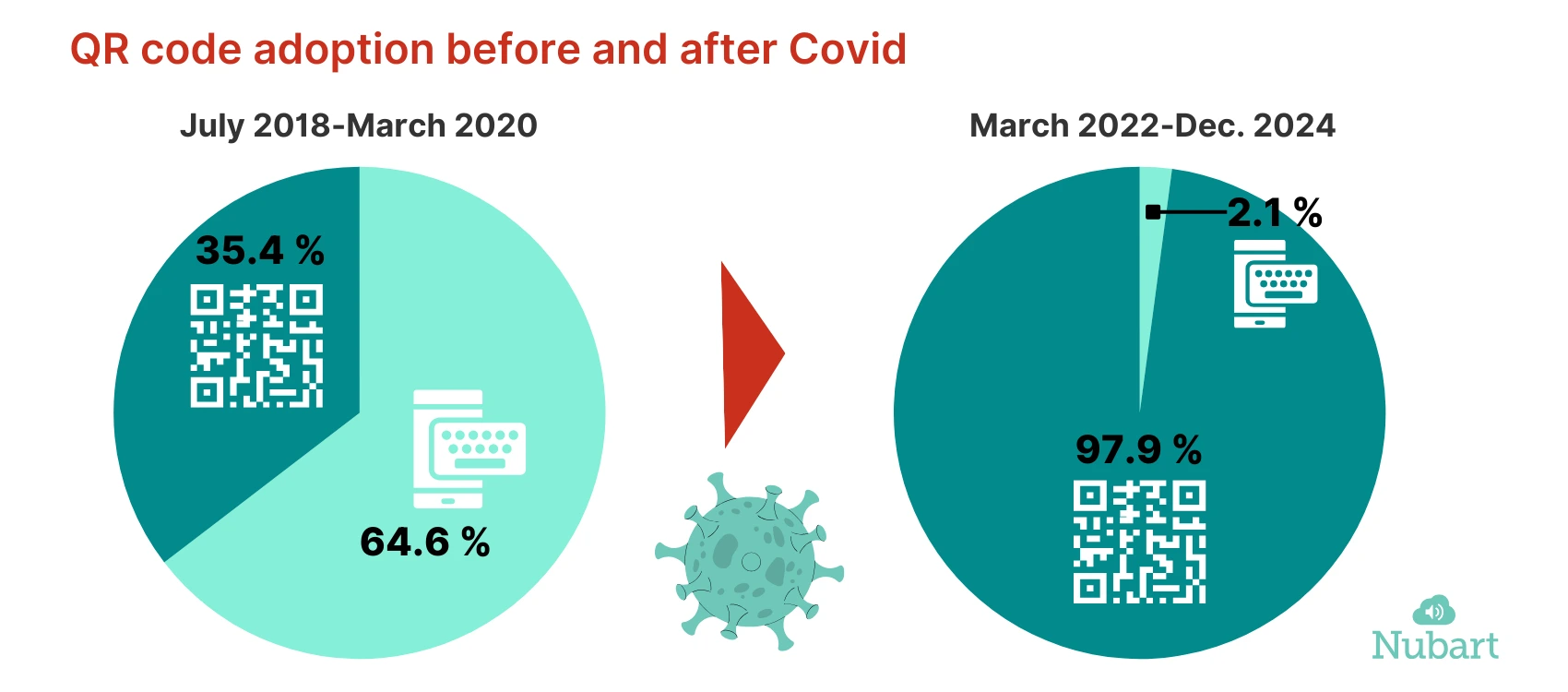
Theres Preißler
Marketing
How to improve the visitor experience with QR codes in museums

The Covid pandemic has made the use of QR codes very popular around the world. The most common objection from museums in the pre-pandemic era, that no one knew how to use QR codes, is now a thing of the past. Nothing is stopping museums around the world from exploiting the full potential of QR codes to minimise the information overload on their walls. This guide explains the context and gives you some interesting ideas.
- QR codes in museums: A short history
- QR code usage statistics: Pre and post-pandemic
- Advantages of QR codes in museums
- Types of content accessible via QR codes
- QR code generators and potential pitfalls
- Ways to use QR codes for additional information
- Implementing QR codes to improve visitor experience
- Conclusion: Why use QR codes in your museum
QR codes in museums: A short history
QR codes (QR stands for "quick response") were invented in 1994 by Masahiro Hara of the Japanese company Denso Wave in response to their need for barcodes that could contain more information than standard barcodes. QR codes are typically scanned with a smartphone camera and lead to digital content or services (usually URLs).
QR codes were first used in museums in the early 2000s, for example by the Mattress Factory in Pennsylvania (2009) or the Brooklyn Museum (2012). But they weren't really successful, people didn't scan them very often.
You wonder why? Well, most people didn't even know what a QR code was or how to read it. Also, you had to install a separate app to read the QR code with your phone, an additional barrier that most people weren't willing to overcome. Even today many of these apps are of poor quality, include advertising and have a dubious origin to say the least. However, as of 2017, most IOS and Android phones have built-in QR code readers, meaning that downloading an app is no longer necessary, as you can simply use your phone's camera.
QR code usage statistics: Pre and post-pandemic
Since the COVID pandemic, QR codes have become much more common as they have been used as a contactless way to access health services such as COVID tests or passes. So people had to get used to them. Today, many people have understood the benefits of QR codes and they are being used for all sorts of purposes and in all sorts of environments, for example in restaurants or bars to access menus, at events to access tickets, on business cards to provide contact details and, of course, in museums.
Would you like us to back up this statement with data? No problem! Nubart is probably one of the few reliable sources of data on the use of QR codes before and after the pandemic. This is because at Nubart we started very early (in 2016!) with the production of PWA audio guides with QR codes.
As many visitors did not know how to use QR codes before 2020, our audio guide cards offer the alternative (and much more inconvenient) option of entering a unique 10-digit alphanumeric code, different for each card, on our nub.art domain.

And as we have many international clients, this has given us the opportunity to find out, with reliable data, how many users have used the alphanumeric code and how many have used the QR code before and after Covid. The results are astonishing:

As you can see, the pandemic has led to a 62.5% increase (from 35.4% to 97.9%) in the penetration of QR codes among the European population. Three times more!
Advantages of QR codes in museums
So why not take advantage of this evolution in QR code usage? Take a look at some of the benefits:
- Maximizing wall space: One of the most tangible benefits of using QR codes in museums is the preservation of valuable wall space. Traditionally, curators have had to balance providing comprehensive information about exhibits with maintaining an aesthetically pleasing and uncluttered environment. QR codes elegantly solve this dilemma by providing a 'digital extension' of the physical space. The exhibition space remains clean and visually appealing.
- Multilingual accessibility: Especially in Europe, where multilingualism is the norm, museums often struggle to provide information in multiple languages without cluttering the exhibition space. QR codes offer an elegant solution to this challenge, ensuring that all visitors feel included, regardless of their native language.
- Easy to update: The nightmare of every curator or exhibition designer is to see a spelling or factual error in the wall texts at the opening of their exhibition. The wall texts are expensive, fully personalised prints. Correcting such errors is laborious and expensive. Digital content, accessible through a QR code, can be corrected in minutes at no cost.
- Enhanced data collection and analytics: QR codes enable museums to gather valuable visitor data, including exhibit popularity, dwell times, and user preferences. This information can be used to improve exhibitions and overall visitor experience.
Types of content accessible via QR codes
Let's talk about the many different types of content you can give your visitors access to via QR codes. Here are a few examples:
- Multimedia content: text, audio, video or images - QR codes allow you to link to a variety of multimedia content that can provide visitors with additional information about exhibits. The content is stored online, for example on your website or through a web application, and the QR code contains the URL.
- Feedback forms/Google reviews: Good Google reviews attract more visitors and feedback helps you to improve your museum. A strategically placed QR code that links to a feedback form or your Google Business Account can motivate museum visitors to leave you a review.
- Newsletter sign up form: QR codes that link to a newsletter sign-up form allow visitors to stay informed about upcoming exhibitions or other museum news.
- Social Media: Visitors who want to follow your museum on social media can easily do so by scanning a QR code. If you have multiple social media profiles, it makes sense to list them all under one URL.
- Audio guide: You can provide access to a (multimedia) audio guide with a QR code. Instead of linking to individual text files or videos, you have a comprehensive and multilingual audio guide that covers the entire exhibition. Currently, some PWA audio guide providers (such as Nubart) allow all of the above to be combined in a single URL: audio guide, multimedia content, opinion forms, newsletter subscription form and social networks.
As you can see, QR codes can be used in museums in a myriad of ways to direct your visitors to all kinds of content, either to provide them with additional information about exhibits, to implement marketing measures or to give them different ways to stay in touch with you.
How to create your QR-codes: "free" QR-code generators and potential pitfalls
To generate a QR code, all you need to do is paste the URL with your content into a QR code generator. You can find hundreds of them on the web, from free to paid, but not all of them are reliable. Since you're going to go to the trouble of printing them out and giving them to your audience, it's important to be aware of the potential pitfalls associated with some QR code generators.
Static or dinamic QR-code?
With a static QR code, you can never change the URL associated with it.
A dynamic QR code, on the other hand, is editable. You can associate it with a different URL in the future without having to reprint it, and you can also get usage analytics.
But beware: the provider of the dynamic code must redirect the user to a domain that they own. Redirects that you can't control are always a potential security risk. The companies behind them are often small and not always reliable. They can damage your reputation by exposing your visitors to unwanted advertising or tracking. If the company no longer exists, the domain will be abandoned. Abandoned domains are often bought up by scammers.
Static QR codes are a safer option because they are likely to point to a URL with a domain that you own and can control. Even if you can't change the URL associated with it, you may be able to change the content that runs at that URL or redirect it yourself, which is really all you need! However, if you choose a dynamic QR code, mitigate the risks by choosing a trusted provider with a proven track record. Also, monitor your QR codes and their destinations regularly.
Limitations of some "free" QR-code generators
Some free QR code generators come with limitations and potential risks.
For example, some generators offer "free" QR codes that expire after a short period of time, usually 14 days, unless you pay for a subscription. Or they limit the number of scans, forcing you to pay once that number is reached. Sometimes this information is really hidden and you may not find out until it's too late. You could be locked into a paid subscription for many years if you've already printed materials with these codes!
So what can you do to generate safe QR-codes?
Many large and reliable companies, such as Canva or Adobe, offer QR code generation as a free and secure add-on to their main product. There are also trustworthy companies like QR-Code Monkey that offer static, secure, permanent and truly free QR codes in their free plan.
And you don't have to go online! You can also download and install software that allows you to create QR codes 100% locally, such as QR-Code Studio.
If your intention is to create a highly flexible multimedia audio guide, you can contact Nubart: our QR codes are static, permanent and reliable, but the URL they point to is completely flexible the content can be edited whenever necessary.
Different ways to use QR codes in museums to provide additional information
As mentioned above, QR codes can be used to provide (more) information about your exhibitions. Here are three ways to do this, with their advantages and disadvantages:
- Separate QR codes for each museum exhibit: For each exhibit item, you place a QR code (usually next to the item) that users scan separately to access information. The advantage of this option is that users only access the information they are interested in; the disadvantage is that they have to scan each item separately, which can seem like a lot of effort. What's more, repeatedly accessing the smartphone camera to scan each QR code will significantly drain the device's charge. Tourists are very concerned about their phones running out of juice. Most visitors give up after the fourth or fifth QR.
- Generic QR code: Create a universal QR code that gives your visitors access to an online (audio) guide (web app) that covers the entire exhibition. Visitors only need to scan the QR code once. From then on, they can navigate through the audio guide by scrolling or clicking on the different elements as if it were a web page. You can place this QR code at different locations in your museum to get as much attention as possible. The advantage is that all the content is in one place (one URL), which makes it easier for users; the disadvantage is that you can't earn with your audio guide if you have a universal QR code that is the same for everyone. Furthermore, if the link to the audio guide is shared on social networks, you will not have reliable data on the users who have actually visited your exhibition.
- Non-transferable QR codes on cards: The third solution is to give visitors individual QR codes (e.g. on small cards) that allow them to access an online audio guide (web application). These QR codes are non-transferable (they can only be scanned with one phone), which means they have commercial value and you can sell them as a BYOD (bring your own device) audio guide. Even better: in addition to the audio tracks and other multimedia content, you can also include links to your social media profiles and feedback forms in the web application, putting everything in one place. Nubart offers this affordable and flexible audio guide solution.
QR codes in museums - how to successfully implement them to improve the visitor experience
You have finally decided to implement QR codes in your museum. But how can you make sure they actually improve the visitor experience? Here are some things to consider:
- Stable internet connection: Your visitors will need an internet connection to access QR codes. Installing a wifi router can help ensure a good connection if you have international tourists visiting your site who would otherwise have to pay expensive roaming charges for their mobile data, or if there is simply no good mobile coverage at your site. The Nubart audio guide can also be used offline once the content has been downloaded: In this case, a good Internet connection in the entrance area would be sufficient.
- Strategic placement of QR codes: Depending on where you place your QR codes, visitors will pay more or less attention to them. The strategic placement of QR codes is particularly important because there is already a lot of information in the museum space vying for the visitor's attention. This stimulus overload is also the cause of museum fatigue, where visitors stop their visit because they are too tired to continue. In addition, QR codes placed next to an exhibit can be difficult to scan if the museum is busy and groups of people form that block the code. Nubart's QR codes are printed on cards that are given to visitors individually, eliminating the need to search for QR codes in the museum. They can also take their cards home and continue listening elsewhere if they're too tired to finish the exhibition or time doesn't permit.
- Mobile content optimisation: The content that QR codes link to is accessed via smartphones. It's therefore very important that your online content is optimised for mobile use, otherwise visitors won't want to use it. Beware of incorrectly formatted PDFs! The Nubart audio guide is designed to be user-friendly, so that even people who aren't digital natives can use it intuitively. The content is also accessible, helping museums to fulfil their mission of being an inclusive place.
Conclusion - why you should use QR codes for your museum
Make the most of the few good things that the otherwise dreadful covid pandemic has brought us, one of which is the spread of QR codes!
QR codes are a modern and sustainable way to provide museum visitors with additional information about exhibits. They are extremely flexible and they can link to multimedia content, social media profiles, newsletter sign up forms, feedback forms or entire audio guides, so that interested visitors can not only learn more about your museum, but also stay in touch with you.
In order not to distract your visitors with QR codes all over the museum and to be able to earn money from your audio guide, Nubart offers individual, non-transferable QR codes that are distributed on cards that allow users to access a user-friendly multimedia audio guide they can even take home with them. Check it out now and use the power of QR codes for the benefit of your museum!
